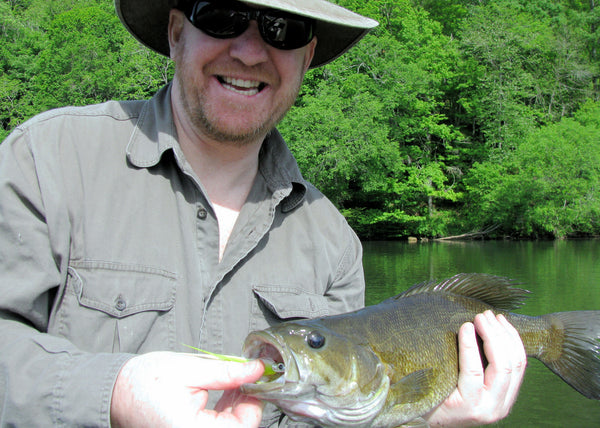Are You Guilty Of the 5 Most Common Smallmouth Fly Fishing Mistakes? Here Are Quick Fixes for Better Float Fishing.
Mike Smith on the New River in Virginia.
Fishing from rafts, drift boats, and skiffs has unique challenges.
I know – I’ve been guiding from a raft for nearly two decades. During this time, I've found there are five common things that anglers floating for smallmouth consistently struggle with.
1. Too much false casting, not enough time with your fly in the water.
It seems obvious if your fly isn’t in the water you won’t catch fish, but newbies to smallmouth float fishing will sometimes make five, six, even ten false casts to present the fly, all the time passing up precious smallmouth territory as they drift by.
The easy fix: Cast with a single haul.
When casting, don't retrieve the fly all the way to the boat – this necessitates excessive false casting – and, instead, work the area at a distance by picking up enough line to load the rod and return it downstream on one cast.
Your goal should be to cover as much water as possible – often targeting ledges, shorelines, grass beds, riffles, and so on – and the best way to do that is to cast with a single haul (or double haul depending on the conditions) and return the fly to the water ASAP.
For example, if we are drifting along a productive length of shoreline fishing a popper, I have my clients “splat” the bug down, drift it ten feet or so, pop it once, then pick it up and present the fly again. We might do this 5 or 6 times along a 100 foot stretch from 40 to 50 feet away, each time repeated with a single haul and ending in another “splat” – the dinner bell that triggers a bite.
If you bring the fly all the way back to the boat and begin casting all over again, you may get only two casts and “splats” on the entire stretch of fishy water, which in the course of a day is a lot of missed opportunities!
2. Not considering the smallie "strike zone."

The biggest problem anglers have drift fishing relates simply to accurate casting and effective presentation, which involves much more than stripping and mending techniques that can vary under different situations and for different flies.
Both casting and presentation entail learning to read water, recognizing where fish hold, and adopting the ability to see underwater structure so that the water is fished properly.
Lucky for you, there is one basic casting and presentation principle that will instantly give your smallie fishing both a boost and a starting point for future improvement.
The easy fix: Cast to the far side of their strike zone and retrieve your fly through it.
Smallmouth are ambush feeders, so the fly needs to be retrieved through their strike zone, not start at the edge and exit it.
For example, when casting to a bank where fish are holding tight, it's best to work the fly directly off the shore. Missing the mark by casting five feet off the bank literally hits the fish in the tail, most likely only spooking it.
Or consider working an eddy or “inverted V” behind a boulder; here it's important to cast to the other side and come through the V instead of landing on the side closest to you. If you don't, eager fish may still chase down your fly, but they are much more likely to turn off at the last minute or simply miss the fly on the take because the poor cast and/or presentation caused unnecessary difficulty.
Proper execution can actually make the difference in a 30 fish day and 10 fish day!
3. Sloppy line control.
Since a stripping basket can be cumbersome to wear on a raft most clients prefer to strip into the floor or their seat if standing. If not careful, it's easy to mishandle the line and get it wrapped around other rods, net handles, or back into the water where it can be pulled under the boat.
A consistent mistake I see anglers make when casting (assuming they have cleared everything in the raft for starters) is indiscriminately letting go of the line and having it wrap around their reel. Once they recover the line, they have usually missed their opportunity at making a clean presentation (possibly missing an instant strike too) and have to begin again.
The easy fix: Guide the line with your thumb and pointer finger.
This entire issue can be easily avoided by simply creating a ring with the thumb and pointer finger and guiding the line through that to the rod hand to begin the stripping, mending, or whatever the circumstances dictate.
Once stripping, be careful to keep the line neat at your feet instead of throwing it in other areas of the boat where it can get tangled.

Flymen head honcho Martin Bawden caught this smallie with a Fish-Skull Crafty Deceiver on a recent trip.
4. Too much slack in your line.
It's absolutely vital to eliminate slack in your line.
Why? Because you must keep contact with the fly to feel the strike.
Poor mending technique, not keeping the rod tip down when stripping, and sloppy casts that pile lots of line on the water are the primary culprits for slack.
Over and over again, I see anglers attempt to start their cast with a sag in their line and the rod tip at eye level, which makes it tough to load the rod.
The easy fix: Keep your rod tip pointed down.

The main thing for you to focus on is keeping your rod tip down near the surface of the water.
This helps you to get the most leverage possible in your hook set, which you'll need because smallmouth have extremely hard mouths lined with thick cartilage.
If using a popper, popping should be done by stripping the line rather than thrusting the rod tip into the air, which introduces large amounts of slack and prevents a solid hook set.
The other value this provides is at the beginning of your cast. Keeping the rod tip low alleviates slack and gets the end of the line moving, which is essential to start the cast.
5. Only fishing half the water.
The backcast is a huge asset to fishing from a boat that not nearly enough otherwise competent anglers have mastered. Your backcast allows you to fish both sides of the boat without having to cast over the guide and the vessel.
This is especially important when sharing the raft with another angler or dealing with wind. Most saltwater anglers are proficient at this, but not so many trout anglers are used to it.
The easy fix: Use your backcast.
Note that this is not the same as an over the shoulder cast. To do this with proper presentation, make a standard overhand cast in one direction but present the fly in the other by delivering and/or shooting the line on the backcast.
Take it to the water!
If you work on these five key areas – covering water efficiently with the single haul, effective casting and presentation through the "strike zone," line control, eliminating slack with your rod tip down, and using your backcast – you will be much more successful at float fishing for smallmouth bass.
Want more articles like this?
Subscribe to the Flymen mailing list at the bottom of the page!
About Mike Smith:

Mike is a fly designer, product development specialist, and lead smallmouth guru at Flymen Fishing Co., as well as the owner and operator of New River Fly Fishing. He's written five fly fishing books, known as the Angler’s Guide Series. His signature flies include the Skull Daddy Crayfish, Foxy Shrimp, Forage Fly, Saltwater Forage Fly, River Creature, Salt Creature, and Egg Sucking Flash Minnow.



thank you
Really great tips and stuff we need to be reminded of periodically.I have been an fishing for 35 yeats and fish for them 3 times a week on the Juniata and Susquehanna Anson the the Pennobscott in Maine every June lo
Leave a comment